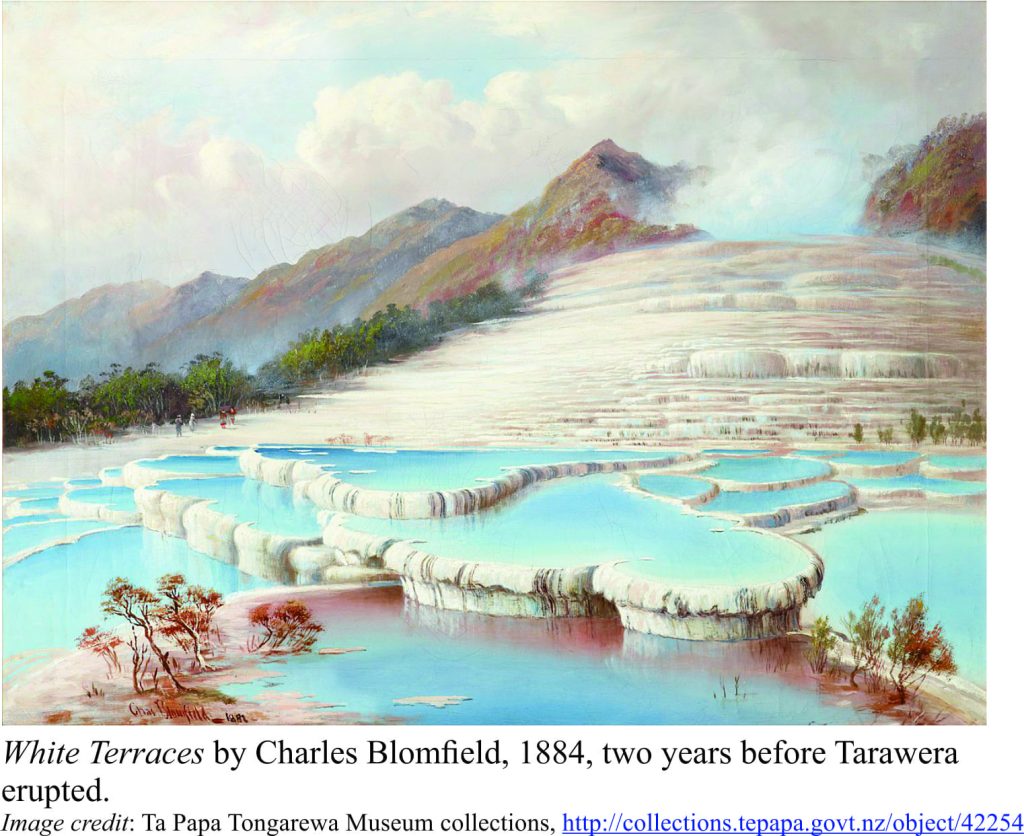
Preamble
A collection of late 19th century lantern slides made by Arthur Whinfield, a native of Worcester, England, has recently been restored and digitized. I was alerted to the Whinfield collection by an old friend Justin Hughes, an archaeologist working in Worcester, UK, who indicated that the collection contained several slides of the famed Pink and White Terraces near Rotorua, New Zealand. These iconic geothermal wonders were destroyed by the eruption of Tarawera, on June 10, 1886.
Lake Rotomahana, in the shadow of Tarawera volcano, looks peaceful enough. Its waters are ruffled only by wind and the wakes of small boats. No hint of impending doom. No hint of the destructive explosions 132 years ago, eruptions that completely changed the local landscape, destroyed a village and its inhabitants, and obliterated a geological icon – the Pink and White Terraces.
New Zealanders look upon the Pink and White Terraces with a kind of fondness, even though no one alive has seen them. Mineral-rich waters spurting from geothermal springs and erupted from geysers above the former Lake Rotomahana, deposited silica in a cascade of rimmed terraces and pools; ever shrouded in steam. As their name indicates, there were two sets of terraces. The larger White Terraces descended 25m, stair-like, into the lake. Their pink counterparts were terraced through 22m. Mineral content was more pronounced in the pink variety, with precipitation of arsenic and antimony minerals, and gold.
The terraces disappeared on June 10, 1886. Eruption of Tarawera was focused along a 17 km rift that extended from the volcano summit, through the terraces, and into Lake Rotomahana. Whether the terraces were obliterated, buried, or partly submerged in modern Lake Rotomahana is still debated.
By all accounts the terraces were spectacular; witness the written testimonies of geologists (like Ferdinand von Hochstetter in 1859) and Victorian gentlefolk, renditions in oil and water-colour (like the Blomfield painting above), and photographs – grainy, black and white, tinted amber with age. This was the late 1800s, and photography was in its infancy, the act of recording an image a laborious process.
Enter Arthur Whinfield. Whinfield was a peripatetic photographer who in the 1880s captured the magic of cities and landscapes in the Americas, Asia, Africa, Europe, Australia, and New Zealand. Part of his legacy resides in a collection of lantern slides (more than 2100 of them) that were donated to the Worcester Diocesan Church House Trust by his wife in 1918. A century later, in partnership with the Worcestershire Archive and Archaeology Service, the slides have been restored, digitized, and made available for public display. Included in the collection are 11 glass slides of the Pink and White Terraces, and the aftermath of the Tarawera eruption.
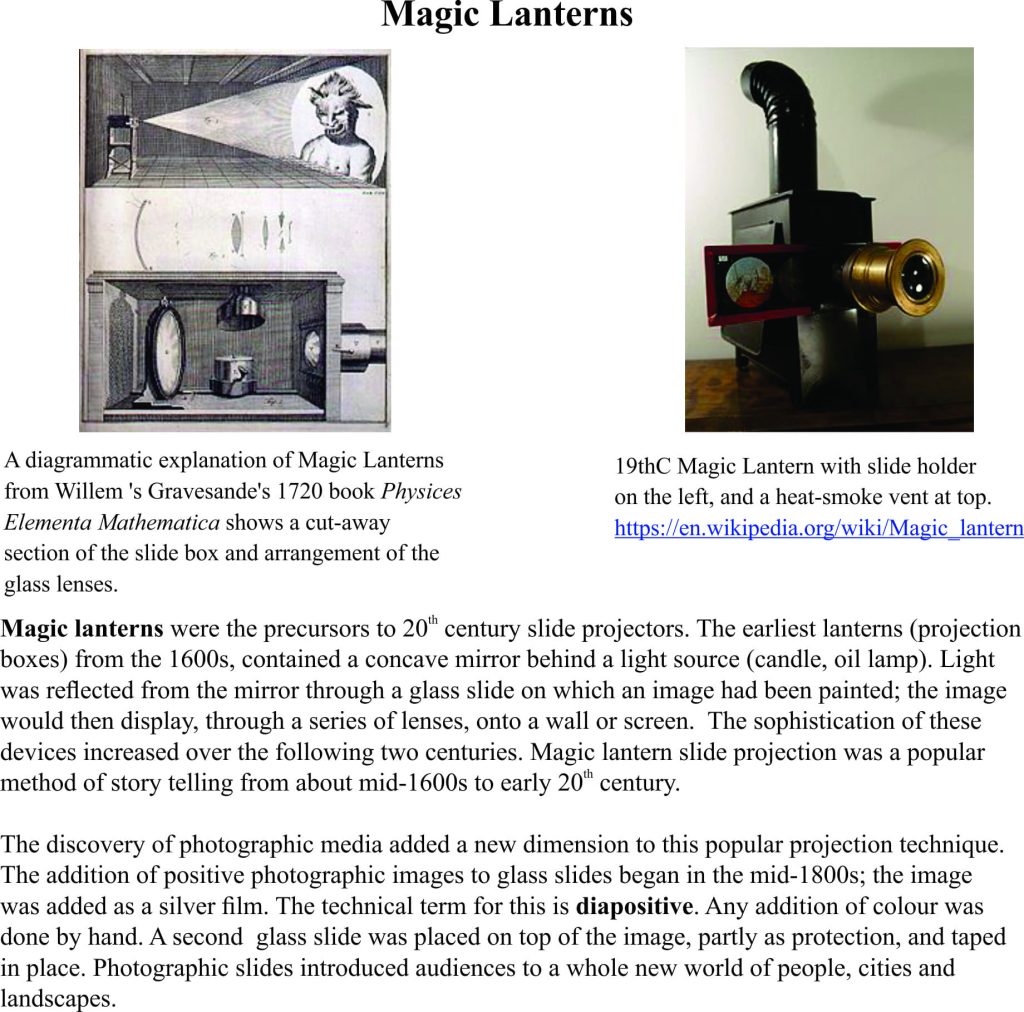
Whinfield took many of the photographs he used in his slides, but also borrowed from other photographers, and this seems to have been the case for several Pink and White Terraces images. Te Papa Tongarewa (the New Zealand National Museum) has an extensive, publicly accessible collection of photographs, paintings and prints related to the Terraces. I was able to identify individual photographers in some of the slides from the Te Papa collection.
Click on each image below for a larger format, then use the back-click arrow to return to the article.
The classic image of the Pink Terrace with Maori guides (or is this a family scene?) and a canoe in the foreground is shown below. This iconic photograph was taken by Burton Brothers Studio in 1885, and later used by Muir and Moodie Studio in a popular postcard (early 1900s; one penny postage required). Whinfield’s slide (left) is a copy of this scene (acknowledging the photographer on the lower left corner).
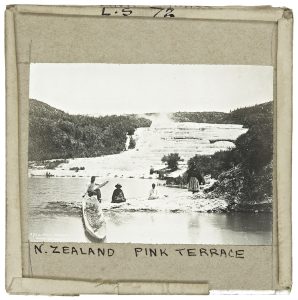
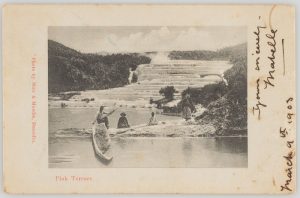
Whinfield slide top; Muir & Moodie postcard bottom
Moodie and Muir also produced a postcard from the White Terraces image below (left); the colour would have been added by hand to the printed photo. The Whinfield slide (right) is an uncoloured version of this image (compare the shape of the steam clouds at the top). The terrace flights are nicely portrayed in this slide.
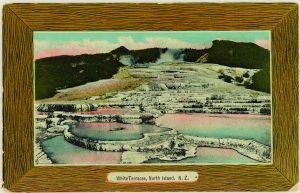
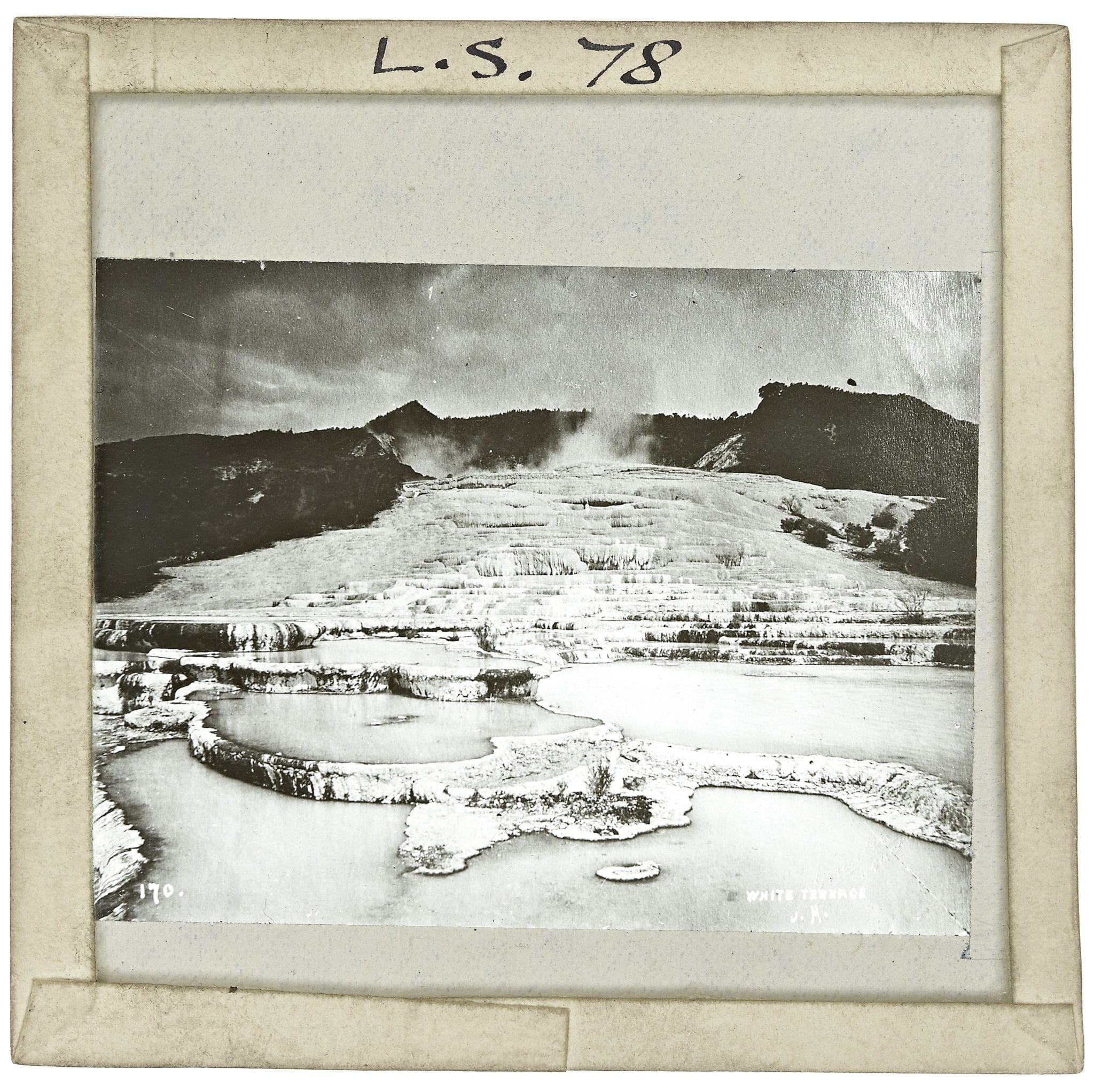
Muir & Moodie postcard top; Whinfield slide bottom
One of the more panoramic views of the White Terraces shown by Whinfield (left) is similar to a photograph taken by Burton Brothers in January-May 1886 (in the Te Papa collection) but is viewed from a lower elevation and records a different steam profile; the original photographer may have taken more than one shot from this location (I have not been able to determine who the photographer was for Whinfield’s slide). Here the terraces clearly dip their toes in Lake Rotomahana. The terraces were a popular tourist attraction, in part because bathing was possible in the lower pools.
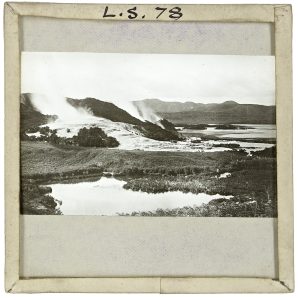
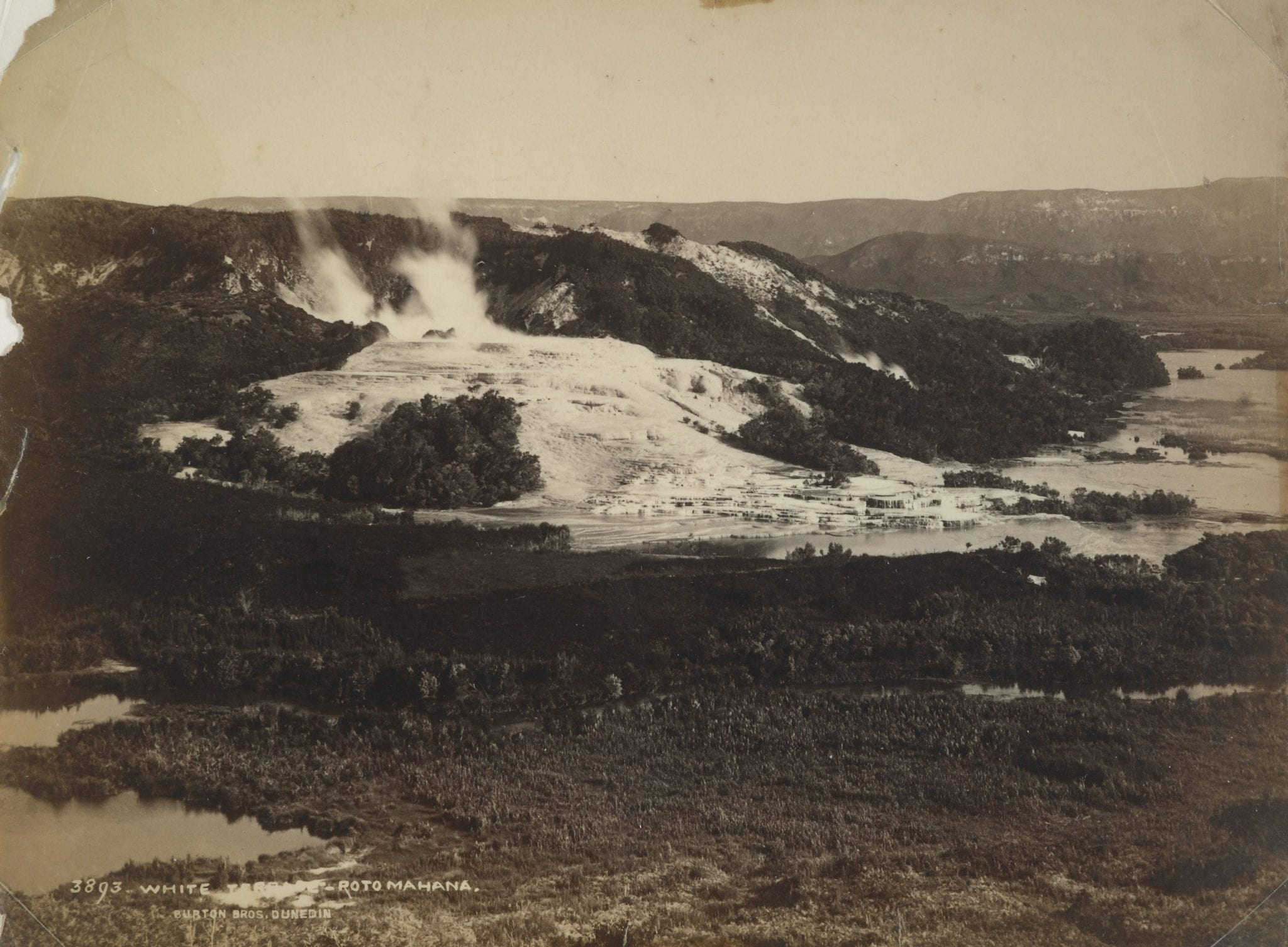
Whinfield slide top; Burton Brothers photo bottom
The original black and white photograph for the three slides below (Pink Terraces), was taken by Charles Spencer. The three Whinfield slides are identical, with the right image slightly enlarged and a mirror of the other two. The view provides some detail of several small pools that appear to have been filled completely by silica.
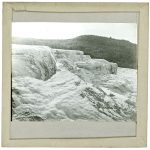
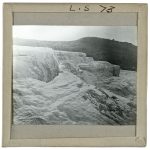
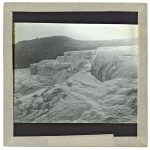
The two slides below show detail of White Terrace pools and the intricate patterns wrought by precipitation of silica. Dark stains daubed on the pool walls may have been algae. I have not been able to determine the attribution of either slide. The second slide is labelled ‘White Terrace Crater’ and may have been taken close to one of the active geysers near the top of the terraces.
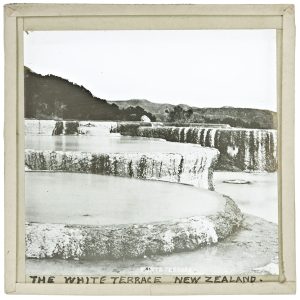
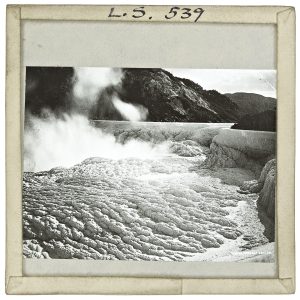
Whinfield’s slide (below, top) showing the aftermath of the eruption at McRae’s Hotel is slightly different to one below taken by photographer George Valentine (1886, McRae’s Hotel and Sophia’s whare) – the man on the right in Valentine’s image has his arms folded; in Whinfield’s slide they are not. The viewing angle is also slightly different – the ladder (foreground) is more oblique in the Whinfield slide. The hotel probably collapsed under the weight of volcanic ash. Other photographs (not in the Whinfield collection) show the back of the hotel to be demolished completely. The trees were also stripped of foliage.
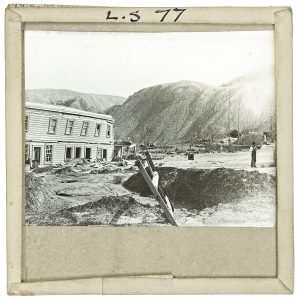
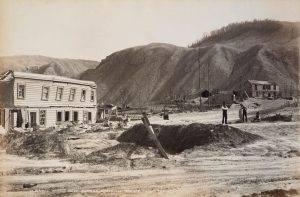
Whinfield slide top; George Valentine photo bottom
The title of the slide below Rotomahana Looking to Site of Pink Terrace, indicates a view towards the former terrace, or perhaps close to it, in the aftermath of the eruption. If the location is correct, the image is important because it shows that destruction of the Pink Terraces was complete. The Mounds of volcanic ash cover almost everything. Characteristic erosional rills suggest rain soon after the eruption, where surface water run-off redistributed the ash (probably towards the lake). I could not determine who the photographer was.
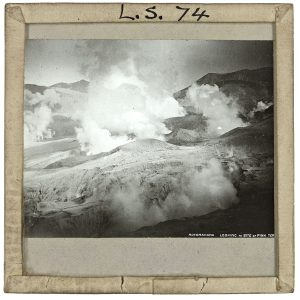
Whinfield’s slides, recently brought to life, are delighting and informing audiences today, just as they must have done when he presented them to an eager 19th century public. These days we never think twice about the projection media at our fingertips. It seems almost to be part of our subconscious, but to Whinfield’s audiences there must have been a sense of excitement, awe, and puzzlement, not just in the images they were seeing, but the fact they were seeing them at all. The havoc wreaked by distant volcanic eruptions, was delivered to their living rooms by a rapidly developing technology.
The Whinfield Terrace collection may not contain photographs of his own taking, but this is not important. An iconic landscape was taking shape in people’s minds, a narrative in images. Folk who may never have left their own village became informed; witnessing the real world shaped by unimaginably ferocious forces – a kind of 19th century Scicomm.
I would like to hear from anyone who has additional information on the images in Whinfield’s slides, particularly information relating to the original photographers.
Credits: The Whinfield collection is owned by the Worcester Diocesan Church House Trust. I am grateful to the Trust for permission to use the digital images of the slides. Thanks also to Justin Hughes of the Worcestershire Archive and Archaeology Service for bringing the slide collection to my attention, for arranging to forward the images, and for his patience with my incessant questions.

















